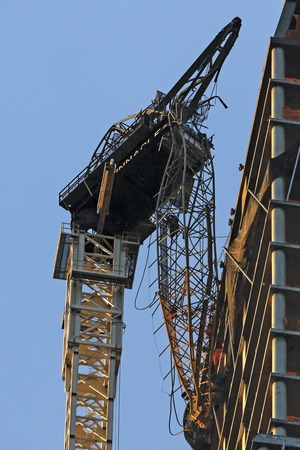
As workers finished tying down a mangled crane jib left dangling for days over Manhattan's West 57th Street in the wake of Hurricane Sandy, engineers involved in the incident moved to design a method for taking the crane down and replacing it with a rig that can finish a 90-story residential tower under construction there.
Forensic engineers have yet to determine a cause of the Oct. 29 partial collapse, though some theories have emerged. Those probing the incident say they are interested to know why the crane failed while about a dozen others in the city did not. It may take weeks or months before anyone knows for sure, they say.
"We have no idea why, but it appears that it did not weathervane like it was supposed to," says Lawrence K. Shapiro, New York City-based crane engineer and author of the industry textbook "Cranes and Derricks" (published by McGraw-Hill, the parent company of ENR). "We're really not looking at this thing forensically right now. We're really in recovery mode," he adds.
Workers for the crane owner, Pinnacle Industries, completed securing the unit on Nov. 4, city officials confirm. In the days after the storm, crane engineers quickly devised what Shapiro calls a "belt and suspenders" system of temporary rigging to tether the lifeless jib—dangling like a wet noodle—to the building.
Plans were finalized on Nov. 2. Still left without power in his Lynbrook, N.Y., office, Shapiro e-mailed three pages of hand sketches to the city's Dept. of Buildings from a local copy center. Minutes later, Mayor Michael Bloomberg told reporters, "We think we have a plan."
The operation began the next day, on a chilly Saturday morning. Crews used a wrench on the crane turntable's pinion gear to hand-crank the boom closer to the building. Workers then rigged three sets of wire-rope cables to the 20,000-lb jib and choked them around concrete columns at floors 72, 74 and 75, Shapiro says.
A second restraint system designed by the project's hoisting engineer, Stroh Engineering Services, was installed the next day. It consists of steel outrigger beams measuring 24 in. tall and cantilevered from the tower at the 74th floor. Suspension cables hung from the beams carry the weight of the boom and provide additional restraint, says Peter Stroh, the company's president.
By all accounts, workers finished the estimated 36-hour job early so the city could lift a standing evacuation order on the area below, including Carnegie Hall.
With the crane secure, the effort now shifts to replacing the damaged crane so Lend Lease, construction manager of the 90-story residential tower—dubbed One57—can finish the luxury apartment building. One57 is scheduled to open next spring and become the tallest residential structure in New York City.
Lend Lease says the recovery plan is still in development. Shapiro and Stroh tell ENR that engineers are leaning toward surrounding the crane's superstructure with netting and scaffolding extending from the face of the tower. Crews would then use the platforms to access the boom and take it apart, piece by piece, from the bottom up.



Post a comment to this article
Report Abusive Comment